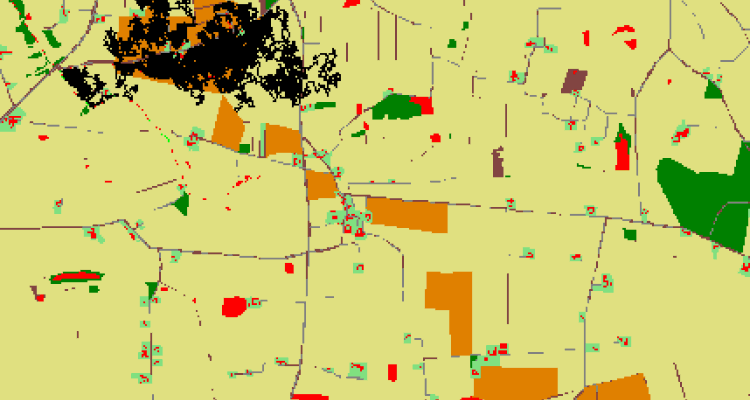
Product
GridWalk/ SmallSteps
SmallSteps is a movement model, simulating movement through an abitrarily complex heterogeneous landscape.
Movement in the simplest representation is based on a correlated random walk, or variants thereof. The landscape is represented in vector format, as polygons and arcs. Movement may be influenced both by the linear elements in the landscape, and by the surface-shaped elements. Output statistics are in terms of parameters of population spread or in terms of arrival probabilities. The first may be useful in answering questions related to the permeability of the landscape and how this is affected by the presence of elements acting as corridors or barriers; the second is useful in a metapopulation context, where the probability of colonization of isolated habitat patches is a critical parameter. The landscape is obtained from ARC/INFO coverages, and can be of arbitrary scale and complexity. SmallSteps has been applied for many different species, and has been extended beyond simple CRW patterns in different ways.
Technical Details
SmallSteps is developed in Smalltalk (VisualWorks 7) and runs in the development environment or as a webbrowser plugin. Required landscape data refer to ARC/INFO coverages, with polygon- and arc-attribute files converted to DBF format. Additional data in (ASCII)grid format can be used. For more information, contact Hans Baveco.
Application
The model can be applied to estimate patch or landscape connectivity, predict colonization probabilities or assess the expected velocity of range expansion. Examples:
- patch connectivity in a metapopulation context. For habitat patches embedded in a complex and heterogeneous landscape matrix, the probabilities of arriving into a patch from all the other patches are estimated (the landscape connectivity-matrix).
- colonization outside current range. From the distribution of dispersing individuals in time and space, the likelihood of isolated areas becoming (re)colonized can be estimated (Lynx in western Europe).
The basic model has been extended in various ways, incorporating e.g.
- home-range movement patterns, enabling us to predict the risk of traffic mortality for foraging Badger.
- migratory movement patterns for North Sea fish species, based on compass-bearing, water currents and depth.
Depending on the type of problem, output statistics may range from records with all positions of individuals at selected times, numbers or densities or residence times in polygons or on arcs, etc. to more summarizing statistics.
Background Information
- Information on the use of the model is to be found in the (outdated) manual.
- An early application of the approach, at a small spatial scale, is described in Vos, C.C. 1999. A frog’s-eye view of the landscape. Quantifying connectivity for fragmented amphibian populations. IBN Scientific Contributions 18, DLO Institute for Forestry and Nature Research (IBN-DLO), Wageningen, The Netherlands, pp. 144.
- Some applications have been covered only in student reports; a notable exception is an Alterra reportnumber 697, Sluis et al. 2003) on patch connectivity for Brown bear in the Italian Abruzzo.
- Jepsen, J.U., Baveco, J.M., Topping, C.J., Verboom, J. & Vos, C.C. 2004. Evaluating the effect of corridors and landscape heterogeneity on dispersal probability: a comparison of three spatially explicit modelling approaches. - Ecological Modelling 181(4): 445-459 with SmallSteps as one of the three approaches.
- Snep, RPH, PFM Opdam, JM Baveco, MF WallisDeVries, W Timmermans, RGM Kwak & V Kuypers 2005. How peri-urban areas can strengthen animal populations within cities: A modeling approach. Biological Conservation 127: 345-355 is based on application of SmallSteps to butterfly movement in the urban landscape.
- Jaarsma, CF, F van Langevelde, JM Baveco, M van Eupen & J Arisz. 2007. A model for rural transportation planning considering wildlife mobility and traffic kills. Ecological Informatics 2(2): 73-82 uses SmallSteps to calculate road crossing frequencies for badgers moving within their homerange.